Hair Shaft Defects Dallas
Hair Shaft Disorders
 Hair shaft defects or hair shaft disorders are common and can indicate an underlying pathology. Evaluation of hair samples under light microscopy can reveal the distinct pattern of injury and thereby facilitate an accurate diagnosis. Hair shaft abnormalities must be evaluated from different regions of scalp to increase accuracy in diagnosis, as there can be wide structural variability even in normal hair.
Hair shaft defects or hair shaft disorders are common and can indicate an underlying pathology. Evaluation of hair samples under light microscopy can reveal the distinct pattern of injury and thereby facilitate an accurate diagnosis. Hair shaft abnormalities must be evaluated from different regions of scalp to increase accuracy in diagnosis, as there can be wide structural variability even in normal hair.
In abnormal and in normal hair, a condition known as weathering can occur in which the hair subjected to normal wear and tear shows signs of damage to the cuticle and cortex. Weathering can be exacerbated by excessive hairstyling, washing, and environmental exposure (swimmin g, sun, etc.). The proximal root is usually spared or less marked in damage with increase toward the distal end where longitudinal fractures, commonly known as “split ends” can become more evident.
To cover the entire spectrum of hair shaft disorders in this brief introduction to the topic lies beyond the scope of what is desired. Instead, a description of the major types of defects will be outlined to introduce the reader to the various types of hair shaft problems that can be encountered.
Fractures of the Hair Shaft
Transverse Fractures-Trichorrhexis Nodosa
Trichorrhexis nodosa is the most common defect of the hair shaft, which appears as beaded swelling associated with loss of the cuticle. The basic cause of trichorrhexis nodosa is mechanical and chemical trauma, which can be exacerbated by the inherent weakness of the hair shaft. Excessive hairstyling and tight braiding/weaving/ponytails can create this problem. The absence of a cuticle can also cause a straight break through the hair shaft (trichoschisis) in addition to the nodular elements of trichorrhexis nodosa.
 Although trichorrhexis nodosa can occur in normal hair exposed to repeated or severe trauma, it can be associated with conditions that predispose toward a weak hair shaft like alopecia areata. The pathogenesis of trichorrhexis nodosa lies in the localized loss of the cuticle cells. The exposed cortical fibers then separate and fray causing the distinctive nodular swelling of the hair shaft that look like two paintbrushes stuck against each other at the point of the nodular swelling. Depending on the extent of the injury, fractures can occur at the nodular swelling leading to patchy or diffuse hair loss.
Although trichorrhexis nodosa can occur in normal hair exposed to repeated or severe trauma, it can be associated with conditions that predispose toward a weak hair shaft like alopecia areata. The pathogenesis of trichorrhexis nodosa lies in the localized loss of the cuticle cells. The exposed cortical fibers then separate and fray causing the distinctive nodular swelling of the hair shaft that look like two paintbrushes stuck against each other at the point of the nodular swelling. Depending on the extent of the injury, fractures can occur at the nodular swelling leading to patchy or diffuse hair loss.
Besides acquired conditions of trichorrhexis nodosa, congenital conditions can also give rise to this problem. Metabolic deficiencies like argininosuccinicaciduria (say that 3 times fast) can cause trichorrhexis nodosa, as arginine deficiency is postulated to cause abnormal keratin formation and therefore structural hair shaft weakness. In addition, Menkes’ kinky hair syndrome which is a defective copper metabolism predisposes toward trichorrhexis nodosa, as copper is also required for proper keratin formation. Menkes’ can also cause pili torti defect (to be discussed).
Acquired trichorrhexis nodosa can be seen in Africans who after years of hair straightening and hot combs can create these nodular fractures. Cessation of these treatments may require 2 to 4 years for the hair to resume to normal. A special condition known as acquired distal trichorrhexis nodosa is seen in Caucasians and Asians in which nodes appear only in the last few inches of the hair shaft due to excessive brushing or back combing.
Trichoclasis
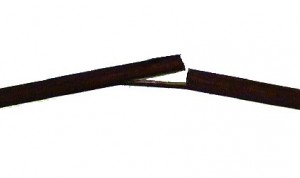 Trichoclasis refers to the common “greenstick” fracture of the hair shaft, consisting of a transverse fracture splinted by an intact cuticle. There is no constant abnormality of the cuticle or cortex in this condition. Trichoclasis can be found in different hair shaft abnormalities or simply following excessive hair care and trauma. Usually when physical trauma accounts for trichoclasis, the affected area shows sporadic and patchy damage, which can be reversed with gentle hair care.
Trichoclasis refers to the common “greenstick” fracture of the hair shaft, consisting of a transverse fracture splinted by an intact cuticle. There is no constant abnormality of the cuticle or cortex in this condition. Trichoclasis can be found in different hair shaft abnormalities or simply following excessive hair care and trauma. Usually when physical trauma accounts for trichoclasis, the affected area shows sporadic and patchy damage, which can be reversed with gentle hair care.
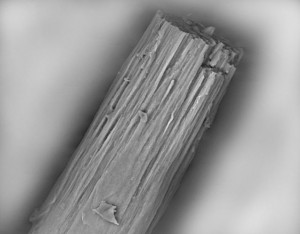 Trichoschisis including trichothiodystrophy
Trichoschisis including trichothiodystrophy
As mentioned above, trichoschisis refers to a clean transverse break across the hair shaft that arises due to the absence of the hair shaft cuticle in the affected area. Although on occasion sporadic, it is usually seen in congenitally brittle hair with low-sulfur content which characterizes trichothiodystrophy. Trichoschisis shows a “tiger tail” appearance with a zigzag pattern of alternating bright and dark bands under a polarizer. The reason for the alternating pattern arises from the alternating sulfur content in the long axis of the hair shaft.
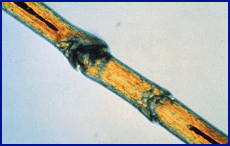 Trichorrhexis Invaginata, or Bamboo Hair
Trichorrhexis Invaginata, or Bamboo Hair
Trichorrhexis Invaginata, or “bamboo hair”, is a nodular expansion of the hair shaft with a ball-and-socket joint appearance. Trichorrhexis invaginata can occur due to trauma in normal hair or appear in congenital hair shaft abnormalities like Netherton’s syndrome, a disorder of cornification. Trichorrhexis invaginata has also been reported to occur in isolated cases of ichthyosis. The reason for this condition is not fully understood. Some thoughts are that abnormal keratinization causes the harder distal segment to slide back over the softer proximal segment. Additionally, a poor attachment of the shaft to the inner root sheath may predispose toward the sliding action of the shaft onto itself.
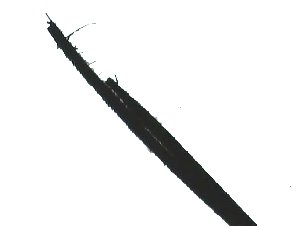 Oblique Fractures- Tapered Fracture
Oblique Fractures- Tapered Fracture
Fractures of the hair that cause a pencil point appearance are due to inhibition of nucleic acid and protein synthesis and therefore mitosis during anagen. Progresive narrowing of the emerging hair shaft may lead to a detached fractured hair with the thinner end near the scalp end. This is most commonly seen in anagen effluvium from cytotoxic chemotherapy drugs that disturb anagen hair shafts.
Longitudinal Fractures (Trichoptilosis)
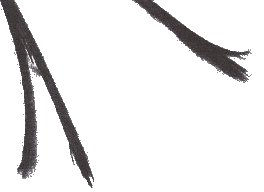
Trichoptilosis is a longitudinal splitting of the distal end of the hair. Following cuticular loss from weathering, cortical fibers separate like the frayed ends of a rope giving rise to “split ends” or “frizzies”. Trichoptilosis is a common fracture arising from trauma.
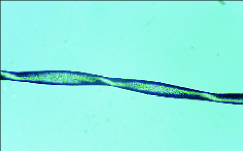 Hair Shaft Coiling and Twisting- Pili Torti
Hair Shaft Coiling and Twisting- Pili Torti
Pili torti refers to the hair shaft that is twisted on its own axis leading to irregularly spaced beads from the twists, making the hair brittle and break easily. Twisted hairs can be seen normally on a scalp, particularly the pubic and axillary hair are normally twisted. Pili torti is usually a congenital condition but can be acquired as well. Children with neural hearing loss have been seen with pili torti which would lead the investigator to insist on early auditory testing. Bjornstad’s syndrome is a rare condition characterized by hearing loss and pili torti. Hypogonadism can be present (Crandall’s syndrome) along with mental retardation. As mentioned, Menkes’ kinky hair syndrome can have pili torti, trichorrhexis nodosa, trichoclasis, and trichoptilosis, making the hair feel like steel wool. A unique form of pili torti is known as corkscrew hair in which many hairs are twisted in a double spiral, which can occur associated with widely spaced teeth and joined fingers and toes (syndactyly).
Irregularities of the Hair Shaft
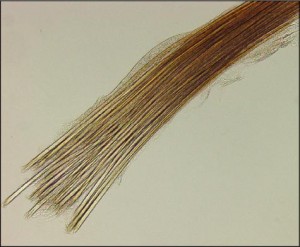 Pili Multigemini and Pili Bifurcati
Pili Multigemini and Pili Bifurcati
In pili multigemini, hairs are formed from two to eight hair papillae and matrices. The hair shafts are surrounded by a common outer root sheath but each hair has its own inner root sheath, arising from one follicular canal. Given this tight arrangement, emerging hairs may look flattened, triangular, or ovoid with possible longitudinal grooves. In adults, pili multigemini is usually found in the beard region, sometimes in a linear distribution. In children, the scalp is typically the affected area. Pili bifurcati refers to hair shafts that emerge from a single papilla but then split into two shafts with their own distinct cuticles which can then rejoin as one shaft, even more than one time. It represents a restricted from of pili multigemini and occurs on the scalp rather than the beard.
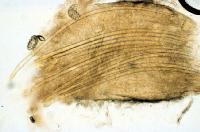 Trichostasis Spinulosa
Trichostasis Spinulosa
Trichostasis spinulosa refers to multiple hairs that are present in one follicular canal with 5 to 50 vellus hairs that are embedded in a large comedo. Trichostasis is now regarded as a normal, age-related process that is a variant of a comedo. It principally affects the chest and back, especially the scapular area and is less common on the abdomen, face, and neck. Topical retinoic acid is the most effective treatment.
Pili Annulati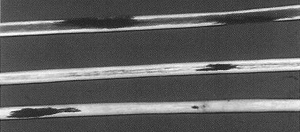 Pili annulati, or ringed hairs, shows characteristic alternating light and dark bands in the hair shaft. Ringed hairs can appear at birth or during infancy and represents a rare keratinzation disorder that can be familial or sporadic. The underlying hair abnormality lies in the cortex. The hair shafts are typically not fragile but when they fracture they do so along the abnormal bands.
Pili annulati, or ringed hairs, shows characteristic alternating light and dark bands in the hair shaft. Ringed hairs can appear at birth or during infancy and represents a rare keratinzation disorder that can be familial or sporadic. The underlying hair abnormality lies in the cortex. The hair shafts are typically not fragile but when they fracture they do so along the abnormal bands.
Pseudopili Annulati
Pseudopili annulati is a normal variant in which light and dark bands are found without an underlying hair shaft abnormality. In pseudopili annulati, the bands are apparent only with transverse illumination, whereas banding is obvious in any kind of light with pili annulati.
Monilethrix
Monilethrix hair shafts are characterized by regularly spaced elliptic nodes spaced 0.7 to 1 mm apart with intervening tapered constrictions.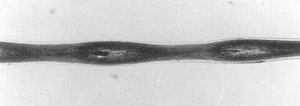 Longetudinal ridges are noted in the internodal regions. Clinically, monilethrix is characterized by fragile, beaded hairs that lead to baldness. Usually, the condition appears in childhood but can occur as late as the second decade of life, mostly affecting the hair on the nape of the neck and the occiput. But other hair-bearing areas like the scalp, facial hair, axillary, pubic, and body hair can also be affected. Brittle, beaded hairs emerge from keratotic papules rarely growing more than 1 to 2 cm long. Fractures occur at the internodal region. Structural defects are present in the cortex and cuticle and arise in the zone of keratinization.
Longetudinal ridges are noted in the internodal regions. Clinically, monilethrix is characterized by fragile, beaded hairs that lead to baldness. Usually, the condition appears in childhood but can occur as late as the second decade of life, mostly affecting the hair on the nape of the neck and the occiput. But other hair-bearing areas like the scalp, facial hair, axillary, pubic, and body hair can also be affected. Brittle, beaded hairs emerge from keratotic papules rarely growing more than 1 to 2 cm long. Fractures occur at the internodal region. Structural defects are present in the cortex and cuticle and arise in the zone of keratinization.
There is no agreed upon treatment for monilethrix with some cases improving and some deteriorating in adulthood. Monilethrix has been associated with other abnormalities like physical retardation, syndactyly, juvenile cataracts, and nail and teeth defects.
Pseudomonilethrix
In psuedomonilethrix, irregular beading (as opposed to regular beading in monilethrix) is seen along the hair shaft. The beaded appearance is produced by expansion of the normal hairs shaft due to indentation and flattening. The thought is that pseudomonilethrix may be an artifactual result of inadvertent trauma with forceps during slide preparation.
Tapered Hairs
Pohl-Pinkus Constriction
Portions of the hair shaft can show abnormal tapering without fracture. These constricted zones are most likely due to interruption of the anagen phase as seen with chemotherapy drugs that can cause anagen effluvium or during a state of hypoproteinemia. The most prominent hair constrictions have been reported following a bleeding duodenal ulcer.
Bayonet Hairs
Bayonet hairs show a characteristic 2 to 3 mm spindle shaped, hyperpigmented expansion of the hair cortex just before a tapered tip. These hairs can appear in normal individuals or be related to a fever or other process that can transiently decrease cortical mitotic activity followed by overcompensation.
Trichomalacia
Trichomalacia represents the damage to the hair shaft that occurs on the underlying anagen hair from repeated hair plucking that occurs from trichotillomania. The hair shaft is twisted and misshapen with irregular melanin deposits. Higher percentage of catagen and telogen hairs can be found. Of note, trichomalacia can also be found in some cases of alopecia areata.
Bubble Hairs
Bubble hairs show rows of bubbles within the hair shafts that resembles a swiss cheese-like loss of cells on cross section. Reported cases (rare) have been associated with highlighting hair and with a hair blow dryer. The thought is that brief, focal heating of damp hair can produce bubbles within the hair shaft resulting in fibers that are dry and brittle. Gentle hair care can reverse this condition.




